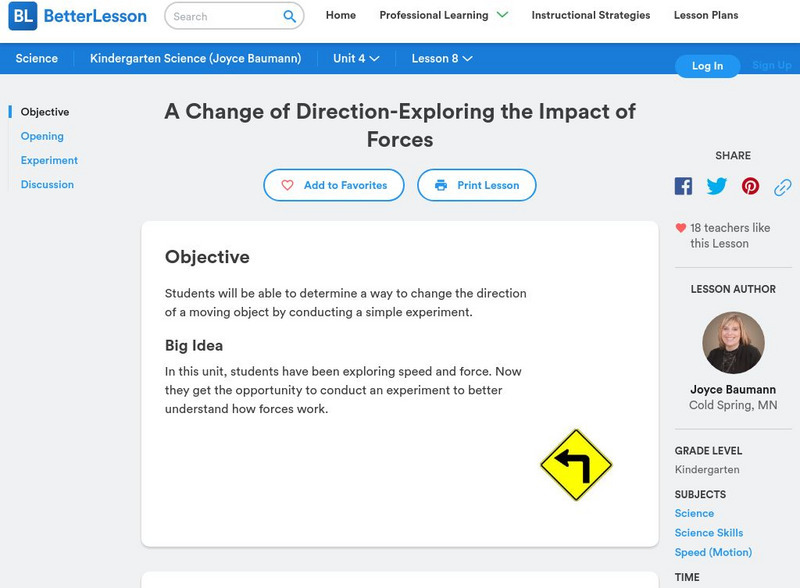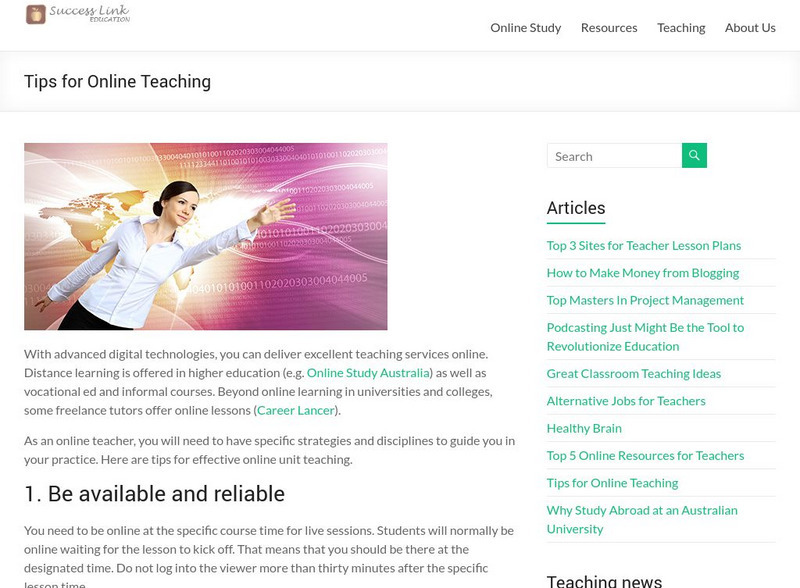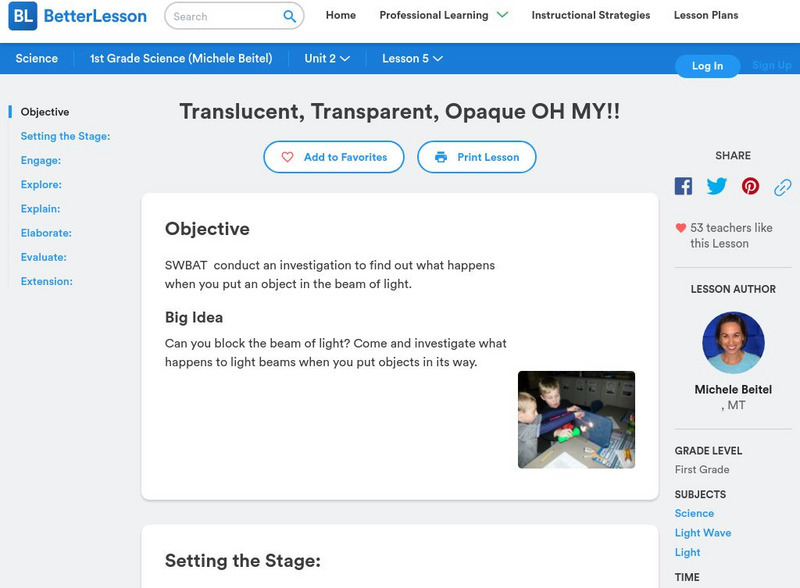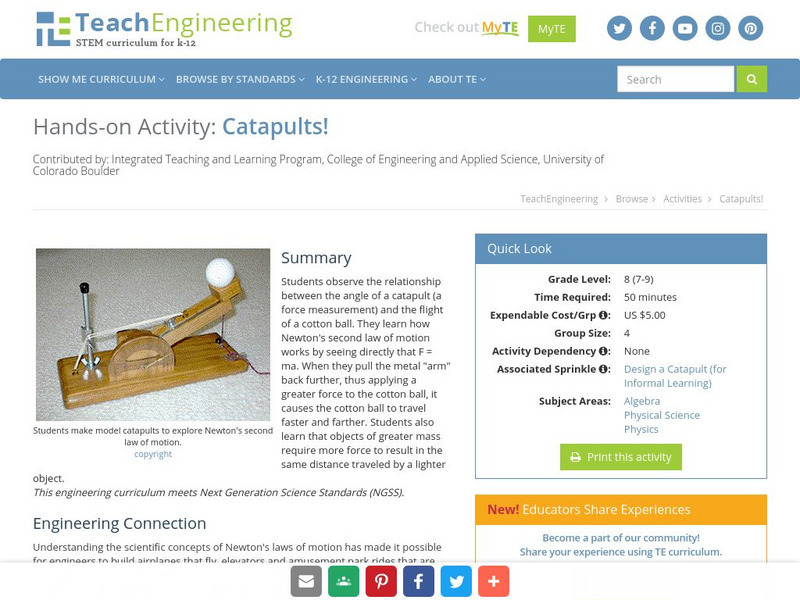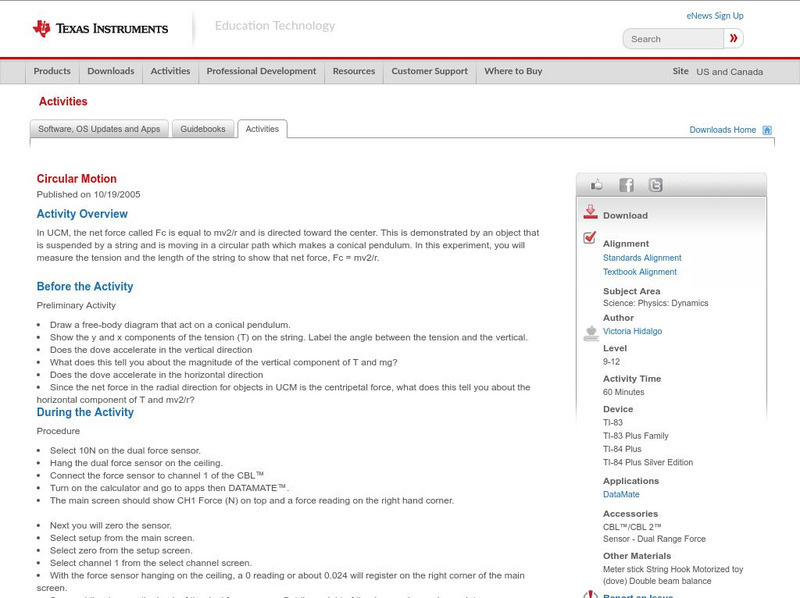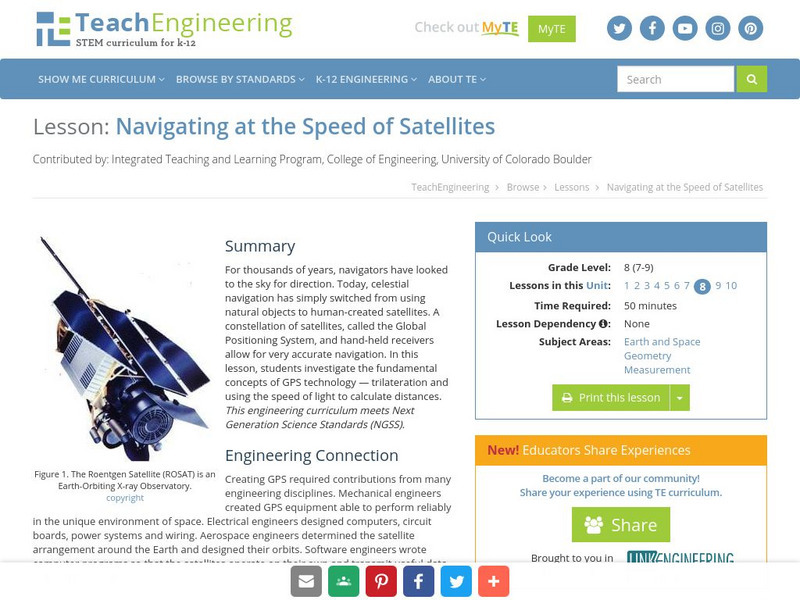Better Lesson
Better Lesson: A Change of Direction
Students will make predictions and conduct an experiment using marbles to figure out what types of things can cause a moving object to change direction. Included is a video of the lesson in action, pictures, discussion questions, and a...
Better Lesson
Better Lesson: A Change of Direction Exploring the Impact of Forces
Students will be able to determine a way to change the direction of a moving object by conducting a simple experiment. Included in this lesson plan are videos of the activity in action, a printable recording sheet, pictures of the set-up...
The Wonder of Science
The Wonder of Science: Ms Ps2 2: Forces, Mass and the Motion of an Object
Cover standards for middle school force, mass, and the motion of an object with this site. Find work samples, phenomena, assessment templates, and videos that directly address standard.
The Wonder of Science
The Wonder of Science: Ms Ps3 1: Kinetic Energy of an Object
Work samples, phenomena, assessment templates, and videos that directly address standard MS-PS3-1: kinetic energy of an object.
Writing Fix
Writing Fix: Action Packed Rain Forest Sentences
For this lesson, Jane Yolen's Welcome to the Greenhouse is used as a mentor text. Students will record their favorite verbs from the mentor text, rank them according to their favorite, and share them. Students will also use interactive...
The Wonder of Science
The Wonder of Science: K Ps2 1: Pushes, Pulls, and Motion
Teaching students about pushes, pulls, and motion? Use this site to plan lessons for students to conduct investigations to compare the effects on the motion of an object when pushes or pulls come from different directions or strengths.
The Wonder of Science
The Wonder of Science: K Ps2 2: Motion Design Solution
The NSTA vetted source includes resources to teach how to analyze data to determine if a design solution works as intended to change the speed or direction of an object with a push or a pull. Included are assessment ideas, videos,...
PBS
Pbs Kids: Design Squad: Build: Helping Hand
Can you design and build a device that will let you grab and drop objects from at least two feet away? Give it a try!
TeachEngineering
Teach Engineering: Classroom Triangles
In this activity, students will use bearing measurements to triangulate and determine objects' locations. Working in teams of two or three, students must put on their investigative hats as they take bearing measurements to specified...
Better Lesson
Better Lesson: What Caused That Change in Motion?
Third graders will observe balls changing direction and determine what made the ball's motion change. They will also use a digital resource to change the position of a digital ball.
Success Link
Success Link: Flying Into Spring
Here are two lesson plans that apply geometric concepts to design objects. The first involves learners as a group following step by step instructions on making a kite. After the review of geometry vocabulary, in cooperative groups the...
Science Education Resource Center at Carleton College
Serc: How and Where Things Move
Students will understand that objects move in many ways, and it takes a forces (pushing or pulling) to move them.
Alabama Learning Exchange
Alex: Fundamentally Fish
The science portion of this activity provides opportunities for students to recognize that structure and function are directly related to specific animals and to their survival. The body shape and the position and size of the mouth of a...
Better Lesson
Better Lesson: Counting 0 10
Students will be able to count up to 10 objects independently using oral directions and modeling by the teacher. This lesson contains detailed plans, pictures of student work, and a printable exit ticket to assess understanding.
Better Lesson
Better Lesson: Counting 0 7
Students learn how to count up to 7 objects independently by following oral directions and modeling given by the teacher. This lesson contains a detailed plan, examples of student work, and a downloadable exit ticket to assess...
Better Lesson
Better Lesson: Counting 0 5
Learners learn how to count up to 5 objects independently by following oral directions and modeling given by the teacher. This activity includes a detailed plan, examples of student work, and a printable exit ticket to assess understanding.
Better Lesson
Better Lesson: Counting 0 2
Young scholars learn how to count up to 2 objects independently by following oral directions and modeling given by the teacher. They also are exposed to the concept of zero. This lesson includes a detailed plan, examples of student work,...
TeachEngineering
Teach Engineering: Imagine Life Without Friction
Students are introduced to the concept of inertia and its application to a world without the force of friction acting on moving objects. When an object is in motion, friction tends to be the force that acts on this object to slow it down...
Better Lesson
Better Lesson: Translucent, Transparent, Opaque Oh My!!
Can you block the beam of light? Students will investigate what happens to light beams when you put objects in its way. These tests will allow them to learn new vocabulary (translucent, transparent, opaque) and discover how these terms...
University Corporation for Atmospheric Research
Ucar: Air on the Go
Students observe that air under high pressure will move toward a low-pressure area and certain objects in the air's path may move in the same direction.
TeachEngineering
Teach Engineering: Catapults!
Students observe the relationship between the angle of a catapult (a force measurement) and the flight of a cotton ball. They learn how Newton's second law of motion works by seeing directly that F = ma. When they pull the metal "arm"...
University Corporation for Atmospheric Research
Ucar: Web Weather for Kids: Create a Portable Cloud
Using six common objects you can make a portable cloud. Get all the directions you need at this site.
Texas Instruments
Texas Instruments: Circular Motion
In UCM, the net force called Fc is equal to mv2/r and is directed toward the center. This is demonstrated by an object that is suspended by a string and is moving in a circular path which makes a conical pendulum. In this experiment, you...
TeachEngineering
Teach Engineering: Navigating at the Speed of Satellites
For thousands of years, navigators have looked to the sky for direction. Today, celestial navigation has simply switched from using natural objects to human-created satellites. A constellation of satellites, called the Global Positioning...
Other popular searches
- Indirect and Direct Objects
- Direct Objects Grammar
- Verbs and Direct Objects
- Spanish Direct Objects
- Direct Objects in English
- Language Arts Direct Objects
- Direct Objects English
- Direct Objects Verbs
- Direct Objects in Sentences
- German Direct Objects
- Compound Direct Objects
- Direct Objects Recognize
